#chimelong spaceship
Note
I’ve seen this video circulating recently and was wondering if you had any idea what’s going on and why the orca is doing this. I don’t know much about cetaceans
Hello! Thanks for the ask.
So this gentleman is Nakhod, one of the adult male orcas at Chimelong Spaceship (which is in China, so it would not be even remotely affected by the SWIMS Act promoted in the video’s caption). Let’s preface by saying that since I don’t actually know this animal or the specifics of his care, I can’t come to any hard and fast conclusions from watching a 20 second video.
The Instagram page you linked is using this clip as proof of “mental health issues.” First off, animals can’t be diagnosed with mental health disorders as we understand them, but I think it’s safe to say they’re referring to stereotypies.
This could absolutely be a stereotypy, and I definitely don’t want to diminish that possibility. However, but its very nature, a stereotypy must be repeated. In this 20-second clip, we only see Nakhod smack his head once before swimming off, so this particular incident doesn’t seem overly stereotypical. Personally, I think it’s more likely he’s displaying misdirected aggressive behavior, particularly since he opens his mouth afterward. As for what’s causing him to be so frustrated, it could be he’s annoyed at the guests. But the fact that he very clearly smacks his genital slit against the acrylic really makes me think it may be sexual.
Chimelong is actively breeding its orcas (Nakhod himself has already sired a calf), so we know their whales are not on birth control (at least not all the time). It’s certainly within the realm of possibility that there was a female in estrus that he was either separated from or rebuffed by. From personal experience, male cetaceans tend to get a little crazy when the females are receptive, and that includes aggressive displays. If I had to go with my gut, I think this is sexual behavior. But again, that’s pure speculation on my part.
So, in conclusion, I don’t know for sure what’s going on. He could be developing a stereotypy, or he could be frustrated, sexually or not. It’s not a benign behavior, but it’s also not automatic evidence of extreme distress.
Note: Normal orca vocals sound sad and pathetic. They’re not screaming or wailing, that’s just how they are. Not sure if the video said “sound on” to hear that or the thuds from him banging the acrylic.
Another note: My overall feelings on Chimelong are really complicated. They purchased their whales from wild captures 8-10 years ago, but their current facility is by far the largest and certainly the most enriching orca habitat ever built. They’ve also had a lot of success breeding healthy calves, which indicates they’re at least doing something right. At the same time, the park is outer space themed for some reason, and since I can’t read or speak Mandarin, I have no idea what the educational value of the aquarium section is. But I hope the Chimelong pod does for China what Shamu did for the United States—inspire a passion for orcas.
#orcas#killer whales#cetaceans#marine mammals#animal behavior#animal welfare#chimelong spaceship#answered asks#specimentality
35 notes
·
View notes
Text
hey, it's me. i'm not coming back to tumblr permanently, but i figured i'd post this here as a virtual diary entry of sorts (and because i don't know anyone irl that wants to talk about cetaceans at the moment). maybe this post will change people's minds, or at least get them thinking. this isn't directed at anyone or anything; it's more to clear my mind and hopefully inform others about orca captivity, seaworld, etc.
the past six months have been very difficult for me. i'm doing better now, but i'm just not at the place in life i thought i would be at right now. throughout my struggles, one of my biggest sustainers has been my passion for animals, and orcas have been my predominant obsession for a while now. the felidae family, especially lions, will always have my heart—they're the first animal i fell in love with, and they will always be incredibly fascinating and awe-inspiring to me. however, orcas have seized hold of me in a way that i can't really describe. everything i've learned about them has blown me away, from their uniquely stable, mostly nonviolent and matriarchal social structure to their incredibly diverse hunting techniques to their cultural behaviors to the wide diversity of their physical appearance. i just love them so much.
as such, it is inevitable that i would encounter debates about captivity in the course of my internet travels in search of ever more information about these animals. for most of my life, i was unapologetically pro seaworld, viewing them as no different from any other zoo or aquarium and their critics as simply having been bamboozled by the film blackfish (although i staunchly refused to actually watch the film until a few months ago, only listening to how seaworld and its supporters depicted the film to me). by the time i started this blog, i had grown more critical of them, as reflected in my pinned post. at that time, i was more critical of killer whale captivity in general than of seaworld specifically. however, after i had to leave my former college in the middle of the semester due to my mental health, i found myself with a lot of time on my hands before the start of the semester at my new college, so i started doing some more research. as a history nerd, i have always been interested in the history of human interactions with wildlife, and the history of human interaction with orcas is unique from an anthrozoological perspective. i became particularly interested in the era just before and after the release of blackfish in 2013—how seaworld, the scientific community, the animal advocacy community, and the public at large responded, and the lasting reverberations of that era today. i fired up the wayback machine and began painstakingly examining any website i could find from that era that had to do with that topic, from awesomeocean.com to seaworldofhurt.com (neither of which are credible sources, btw: awesome ocean is basically a seaworld-funded buzzfeed clone and seaworld of hurt is run by peta). what i found blew me away in the worst way possible.
the website i spent the most time on was askseaworld.com/ask.seaworldcares.com (https://web.archive.org/web/20160110084856/http://ask.seaworldcares.com/). i cross-checked the information posted there with a little-known website i urge everyone to check out, https://www.seaworldfactcheck.com/ (which i didn't have to use the wayback machine to access, because seaworld has attempted to purge pretty much everything related to the blackfish era from their websites whereas anticap websites haven't). only a handful of the sheer volume of questions they received were fact-checked by seaworldfactcheck, so i had to check a lot of them myself. i was flabbergasted by the responses seaworld posted on askseaworld. they ranged from just your typical corporate pr messaging to outright lies. a common thread running through all of them was a complete refusal to admit that they ever did anything wrong in their entire history. that's something that the entire zoological field has trouble doing, but never had i seen it on such clear display. for example, they audaciously claimed that kohana's calves weren't inbred, and that the degree of relatedness between kohana and her calves' father, keto, is standard practice in ex situ breeding programs. meanwhile, the aza says that inbreeding is to be avoided here and here. additionally, these two pages, while they focus on pedigree dogs, stress that a coefficient of inbreeding (the likelihood of having identical alleles from a common ancestor on both sides of the pedigree) over 5% leads to problems, and kohana's calves had an inbreeding coefficient of 6.25%. i'm no geneticist, but sw's response to that question is questionable, to say the least. when asked about the whales they captured from the wild, they only used the word "collected", which came across to me as corporate doublespeak attempting to obfuscate the trauma and utter cruelty of ripping these complex, cultural, family-oriented animals from their families permanently for the primary purpose of entertainment—which, regardless of their current messaging, was undeniably the purpose of seaworld when it was founded (see page 9 of that link, which is also an incredibly well-researched and well-referenced argument against marine mammals in captivity that cannot be dismissed out of hand just because it comes from an anticap source). they refused to offer even a semblance of regret for how those captures were carried out—even a halfhearted "society's standards for animal welfare were different back then" or "at the time, we had no idea how this sort of thing could impact these animals" would be better than what they said, which was simply that "those were a long time ago". ok, but just because we didn't know it was wrong back then doesn't mean it wasn't wrong. it was just as wrong then as it was now, and seaworld doesn't even say it would be wrong for them to do so now; they just repeat the same line over and over about their last captures being decades ago.
however, none of these are as bad as the askseaworld response that appalled me the most. it genuinely made me question every positive thing i had ever heard about seaworld. unlike most of the questions, the name of the person who asked it was not stated, giving the impression that seaworld perhaps posed it to itself as a sort of preemptive strike. this was their response:

this is one of the most unacceptable and heartrending things i have ever seen written by any person or entity related to animals. nonhuman animals are not a monolith; there are millions of species of animals out there, each one with its own unique behaviors, social structures (or lack of social structures), role in the broader web of life, and ways of thinking. to suggest that the social dynamics of all the animals in the world are so similar that they can be crammed into the word "most" is utterly presumptuous and incorrect. at the risk of sounding like a vegan activist, i will dare to say that this statement enforces a harmful anthropocentric worldview that implies that humans are the only species that could experience distress at the loss of a loved one. by declaring that most animals just get over a member of their social group dying without a second thought, seaworld dismisses years upon years of science revealing the social lives of animals from cows to rabbits to, yes, orcas. including parents in this statement is especially ironic, considering that mother orcas undeniably demonstrate some of the strongest bonds with their children in the animal kingdom, arguably even stronger than humans—after all, when's the last time you met a human who has never left their mother's side their whole life? with this statement, seaworld revealed a callous indifference to the rich inner lives of their animals, focusing on the grief their human employees feel when an orca under their care dies over the far greater grief the orcas themselves probably feel when a member of their actual family dies. orcas have inherent worth and dignity and that deserves to be acknowledged, not dismissed so we can all go back to empathizing with the trainers. i'm not dismissing the trainers' grief in any way; i'm not trying to say the reverse of what seaworld said. rather, i'm saying that their grief shouldn't be seen as more important or more valid than the grief of the orcas.
some might say that this single response, no doubt composed with the help of a public relations firm, should not be taken as representative of seaworld or its trainers as a whole. to that, i would say that while individual employees (i.e., orca trainers) of seaworld may not agree with this statement, it can be presumed that this is or was at the time the official stance of the corporation that is seaworld parks and entertainment, incorporated. personally, i do not think it is possible to separate support for the trainers from support from the larger corporation running the show, as financially supporting seaworld inevitably supports the corporation (which has asked its employees to do some pretty unethical things) and its stakeholders, not just its employees. customers' money is not going into the pockets of trainers; it's going into the corporation first and foremost to pay the CEO and stakeholders before a paltry amount per dollar is redistributed at the company's whim to their trainers and rescue efforts.
as i processed this response, i decided to do some more research into the anti-cap side of things. i found that, despite seaworld's constant claims that they are a science-based organization, i could not find a wild orca biologist (meaning somebody who researched orcas exclusively in the wild, without a personal connection to seaworld or any other captive entity) who supported keeping orcas in captivity in general or seaworld specifically. of course, i don't know all of the wild orca biologists in the world, so i could be missing somebody, but all of the big names who conducted the most groundbreaking research on orcas in their natural habitats condemn orca captivity, as these links show: michael bigg, alexandra morton, ken balcom, deborah giles, naomi rose, paul spong, erich hoyt, and ingrid visser. these are not peta activists—they are experts in their field with phds and decades of experience! pro-caps often accuse anti-caps of only listening to their emotions instead of science, but how is it valid to dismiss all of these esteemed scientists as being biased when their research and experiences in the field with orcas are the reason why they are against captivity? seaworld tends to portray itself as objective and rational and their opponents as emotional and irrational, but how can all of these orca experts who have nothing to gain financially from opposing seaworld be completely incorrect when it comes to captivity and the corporation that profits off of having them in captivity be completely correct? the most praise directed towards orca captivity from a wild orca researcher i could find was robert pittman referring to them as "sacrifical animals" who display obvious signs of poor welfare but need to be kept in captivity anyway so the public will fall in love with their species; hardly a glowing endorsement. in her presentation at the california coastal commission, naomi rose said something (starting at 10:36) that really opened my eyes. she said that she does not believe that seaworld and its trainers are being intentionally cruel to their animals, but that they simply do not understand them: "if they don't know what normal is, then they cannot know what abnormal is." she's saying that in order to build a solid foundational understanding of a species' normal behavior, one must spend as much time as possible observing that species in its normal, evolutionary, default way of living, i.e. "the wild". without doing this sort of firsthand research or drawing upon the scientific literature produced by those who have, one cannot claim that an animal of this species in totally abnormal conditions is displaying normal behavior. the aim of captivity for any species should be to replicate an animal's normal way of living as much as possible to allow the optimal amount of normal behaviors to be expressed, and what the scientists i have mentioned claim is that orca captivity is failing at replicating this way of living.
the institution of orca captivity in its current form takes away almost all elements of what would be considered an orca's normal lifestyle, from hunting to staying in their matrilines to communicating with other orca pods to moving large distances on a daily basis to choosing who they mate with and when to experiencing changes in water depth, light level, pressure, salinity, currents, waves, and weather. they destroy their teeth , exhibit increased aggression levels with each other (compared to their remarkably stable social structure in their natural habitat), and experience dorsal fin collapse, a phenomenon that seaworld has declared has no implications for these animals' well-being despite conducting zero research on it (seriously, imagine if all male lions' manes fell out in captivity and zoos shrugged their shoulders and said it was fine without ever exploring why). manmade enrichment and training can supplement this, but in my opinion it can never replace it entirely because these animals live such active and complex lives in the wild. basically the only natural thing that they are allowed to do in captivity is breed (but again, they can't always choose when they mate and with whom). i and the above scientists believe that orcas' welfare is already so compromised in captivity that removing this element is worth it to protect future orcas from having to endure this and to reduce demand for wild captures as genetic diversity in breeding programs runs out (to my knowledge less than 30 orcas worldwide are part of captive breeding programs) and, as we're seeing in china, new parks opening demand more orcas faster than they can be born. more and more and more breeding (chimelong has been breeding especially rapidly, forcing katenka to have 3 calves in just under four years when a wild orca would only have one calf in that time frame, and shanghai and kamogawa sea world are breeding as well) does not quell the need for wild captures; it drives it. the success of seaworld parks in the usa is likely a major factor in why businesspeople in other countries (china, russia) have started majorly investing in capturing orcas in the past decade.
that brings me to something that has really disturbed me lately. over the months since chimelong spaceship opened in china, i have seen a continual backwards shift in what the pro-cap community has considered acceptable. the number of pro-caps that i have seen praising chimelong while giving mere lip service to the fact that most of their orcas were traumatically ripped from their families is astounding. you cannot praise a facility while ignoring the source of their animals, and you cannot condemn the fact that these orcas were wild-caught while throwing your support behind the industry driving demand for these captures. i highly doubt people come to a theme park that is literally shaped like a giant spaceship with any intention of being educated or supporting conservation; they come there to be entertained, just as people came to seaworld solely to be entertained for much of its history. also, pro-caps must not ignore the fact that spaceship's parent company, chimelong, operates a deplorable circus, chimelong international circus, that abuses wild animals and forces them to perform dangerous and demeaning tricks. chimelong also operates zhuhai chimelong ocean kingdom, at which cruelty and neglect have been documented (china cetacean alliance may be connected to animal rights groups, but that doesn't mean the results of their investigations are completely invalid). this report about chimelong and shanghai, including concerning animal behavior and misinformation being spread by chimelong trainers, is also incredibly concerning. even if no outright orca abuse has been recorded at shanghai, chimelong, or other new facilities yet, it is still concerning that their sister facilities engage in such blatant abuse with other animals. if three out of four restaurants in a chain have been caught on camera serving moldy, spoiled food to their customers, it's a pretty safe bet that the fourth one will eventually be caught doing so too.
anyways, that about wraps up what is by far the longest post i have ever made on tumblr. nobody i know irl really cares about cetacean captivity, so i wanted to vent here. i am not the most anti-cap anti-cap out there for cetaceans, but i definitely am more so than i used to be. heck, i'm not even universally opposed to something like the whale sanctuary project being constructed—wikie, inouk, and keijo are likely going to be transferred out of marineland antibes soon, and even though the sanctuary model is totally unproven, i can't help but feel that their welfare would be better there than at the places they are rumored to have been sold to: kobe suma sea world, kamogawa sea world, and port of nagoya public aquarium. the former two feature tank complexes that are barely bigger than tokitae's infamous "whale bowl", and kamogawa still does waterwork. also, it is rumored that marineland antibes wants to split up their orcas between these facilities, which wouldn't happen at the wsp and would make the stress of the move even worse. however, i absolutely cannot stand the wsp's messaging; they spread a lot of poor-quality information. as many others have said before, the sanctuary model could be super risky, and it's doubtful they could construct it in time if the french government allows the orcas to be moved, considering marineland antibes wanted these orcas gone yesterday. as usual, captive orcas are stuck between a rock and a hard place.
however, i want to make one thing clear: i'm not an expert or a scientist, nor do i wish to portray myself as such. i'm just a bored college student who is obsessed with animals and has too much time on her hands. i try to get as much of my information from experts and scientists as possible, but i do not claim to be an expert and i'm always willing to learn from the scientific literature and from people who can engage in respectful discussion. in regards to captive orcas, i would certainly love to be wrong.
#katherine speaks#orcas#orca#killer whale#killer whales#seaworld#cetacean#cetaceans#zoology#animal welfare#chimelong spaceship#shanghai haichang ocean park#cetacean captivity#orca captivity
12 notes
·
View notes
Text





More images of the Chimelong pod, from here: https://www.themeparx.com/chimelong-spaceship/
#chimelong ocean kingdom#chinese orcas#russian orcas#russian killer whales#killer whales#orcas#chimelong spaceship
20 notes
·
View notes
Text

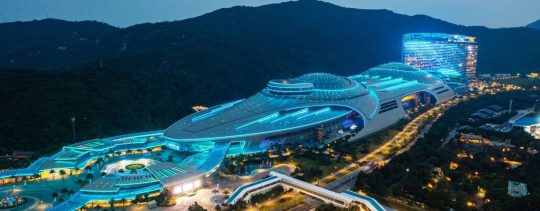
Chimelong Spaceship Theme Park in Zhuhai, China
World’s Largest Indoor Theme Park
11 notes
·
View notes
Text
The record breaking waves at Chimelong Spaceship’s main tank are turned on randomly throughout the day, not only during shows. The whales enjoy the waves very much, and the trainers let them express themselves in the waves (surfing, fast swimming, sliding, etc.). So far, the whales have not been trained to do any particular behaviors with the waves, mostly with regard to the safety of the whales and staff.
95 notes
·
View notes
Text
youtube
Officially released footage of the birth of Yilong, the first killer whale born in human care in China. The calf, born in 2019, is the first of three successful killer whale births at Chimelong Spaceship’s new oceanarium, which opens to the public this month.
#look I am VERY begrudgingly more and more impressed with this place#and honestly it should embarrass western parks#their facilities are better than anything we have#and breeding orcas is not easy to do#clearly things are being done right#chimelong ocean kingdom#chimelong spaceship#orcas#killer whales#cetaceans#marine mammals#Youtube
27 notes
·
View notes
Text
Not gonna lie, it's pretty wild seeing how quickly pro-cetacean captivity people went from constantly reminding others not to judge a facility's quality or their cetaceans' welfare based on short clips uploaded to social media to... universally praising Chimelong Spaceship's (the latest captive orca facility to open in China) quality and their orcas' welfare based entirely on Chimelong's official posts and short social media clips from visitors. It's just baffling to me how the same people who constantly criticized anti-cetacean captivity people for willfully misinterpreting out-of-context footage to fit their agenda (which is undeniably something anti-caps have been guilty of on numerous occasions) are now doing the exact same thing. It's just as inaccurate when a pro-cap sees a ten-second video filmed on a smartphone of a bunch of orcas swimming around their tank and claims "look how happy the babies are interacting with each other in a Totally Natural Social Structure! look how enriching their wave machine is! don't worry about the one lying motionless and skewed on its side at the bottom of the tank, it's just resting" as it is to see that same video and claim "captivity is making these orcas lose their minds! look how they endlessly swim in circles; that means they're depressed and suicidal!"
It really just goes to show that a lot of pro-caps (I'm not accusing all of them of being this way, though; I try to avoid making sweeping statements about people based on their ideology) aren't willing to think critically about this new wave of captive orca facilities that are opening up; instead, they're just so relieved that orca captivity isn't destined to die out in the next decade or so after all that they immediately throw their support behind any new orca facility. Apparently, a wave machine and bubble jets in the tanks render null and void the much broader concerns about the impact of captivity on these animals, as well as the lasting trauma of their capture, which must not be forgotten about and needs to be kept in mind whenever any footage of these new facilities comes out; it's essential context. Additionally, I haven't seen anyone take the horrific animal abuse and wild capture of elephants perpetrated by Chimelong International Circus and other parks owned by the larger Chimelong company into account when evaluating whether Chimelong Spaceship is a place they feel comfortable supporting. Chimelong Spaceship is in a building shaped like a giant sci-fi spaceship and has robots and fictional creatures as decorations; none of those features impact animal welfare, of course, but they demonstrate that people clearly aren't going there expecting to learn anything about animals or about conservation. It's like saying a visit to Frontierland at Disney World inspires people to care about the history of the American West. Marine theming is not proof of an underlying conservation ethic or message. The orcas are just another theme park set piece and are presented as such. People aren't becoming magically enlightened about the plight of our oceans and the majesty of marine mammals by watching them swim in a tank for a few minutes before going back to riding roller coasters. You really can't claim to be totally opposed to wild captures and then support a facility that paid for the wild capture of orcas just a few years ago and has not given any indication that it wouldn't do so again. Supply and demand exists, and if these new captive orca facilities do well, new ones are going to open, and it's really not possible to breed orcas quick enough (even if they are bred far too often, as Katenka has been) to meet the demands of the market for more orca facilities without wild capture. I don't judge people for being pro-cap, because while I find that opinion borderline morally indefensible, I used to be pro-cap myself so I understand where they’re coming from. Also, I try to respect people’s opinions as long as they have had thought put into them, rather than being snap judgments. I also am not trying to condemn or pass judgment upon people who praise Chimelong; everyone is capable of experiencing cognitive biases, including myself. I just wish people would realize that their stance on cetacean captivity never renders them less likely to be biased.
#cetacean captivity#chimelong spaceship#orca#orcas#killer whale#killer whales#katherine speaks#animal welfare#zoology#orca captivity
4 notes
·
View notes
Text
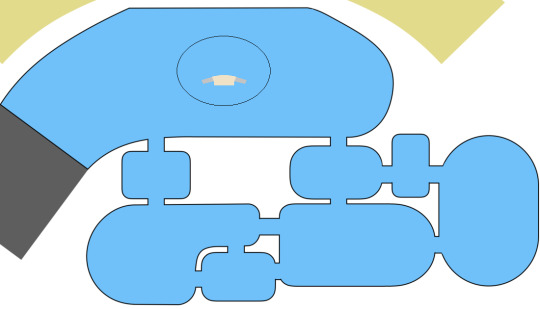
I made an approximation of Lolita's whale bowl compared to the Chimelong Spaceship complex.
Going by this main pool being 102 meters across, and Lolita's pool being 80 x 60 feet (according to @the-whale-pool).
The work island was just approximated, I have no measurements.
6 notes
·
View notes
Text
Public trial operations of Chimelong Spaceship begin September 16, 2023.
https://mp.weixin.qq.com/s/waPzQTz1OnHFSdkgMcKp7w
133 notes
·
View notes
Text
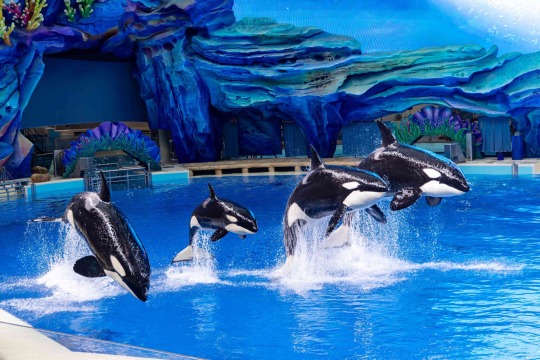



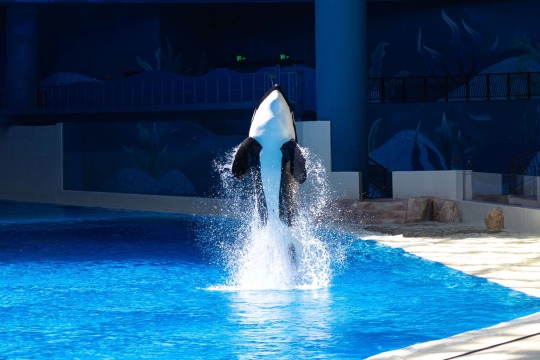
Ahead of Chimelong Spaceship's grand opening, Chimelong has officially released new photos and details about their killer whales (paraphrased):
Over the past ten years, Chimelong has carried out scientific research of and successfully cared for 12 killer whales.
The three killer whales born at Chimelong are Yilong 一隆 (the first killer whale to be born at a Chinese aquarium), Loki 洛基 (the first killer whale calf to be hand-raised at a Chinese aquarium), and Katniss 凯特尼斯 (the first "second child" killer whale calf to be born at a Chinese aquarium).
Chimelong is emphasizing their dedication to conservation and research, and they are touting the revolutionary size and design of their killer whale exhibit.
62 notes
·
View notes
Text
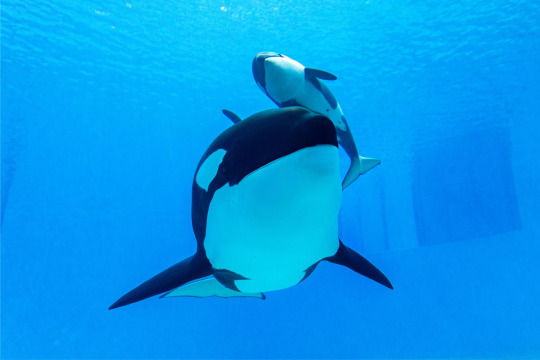
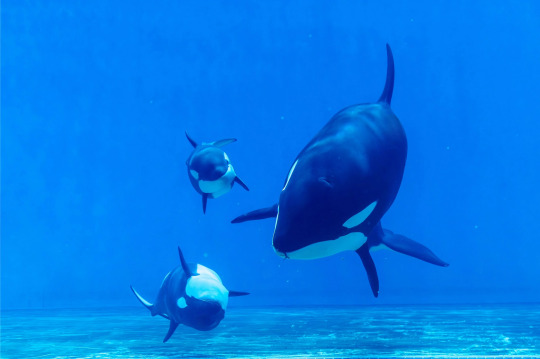
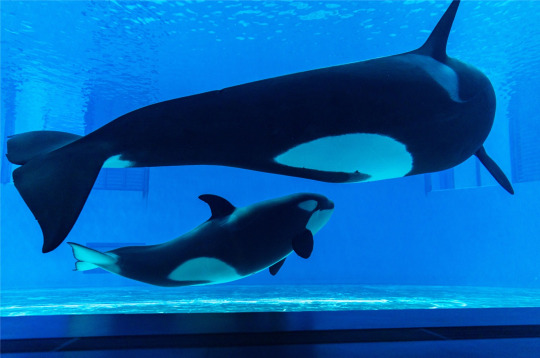


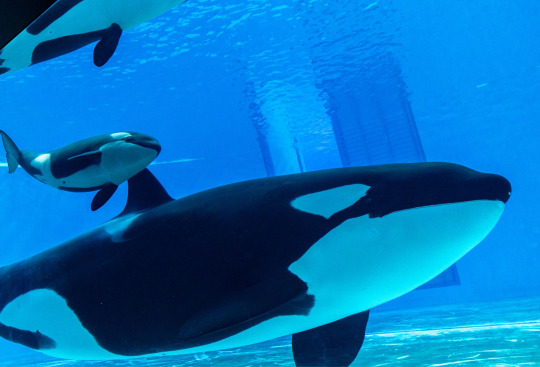



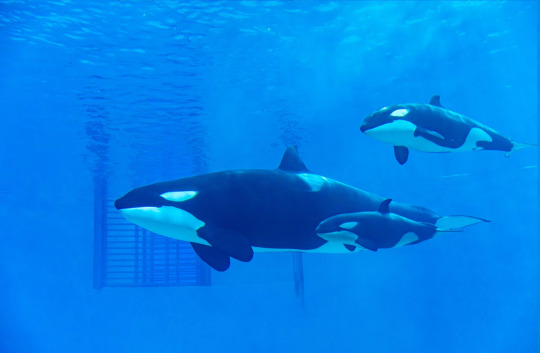






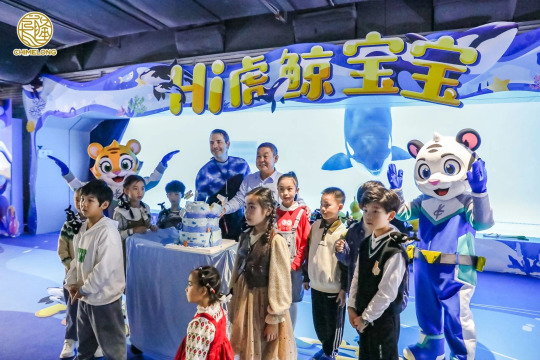

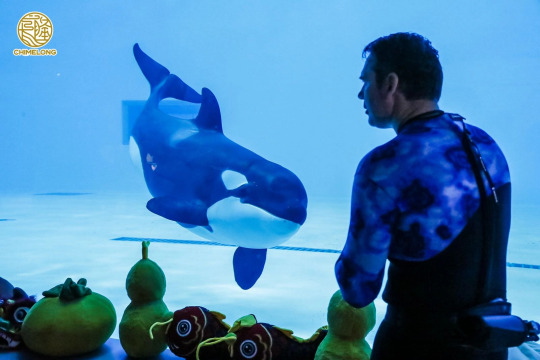
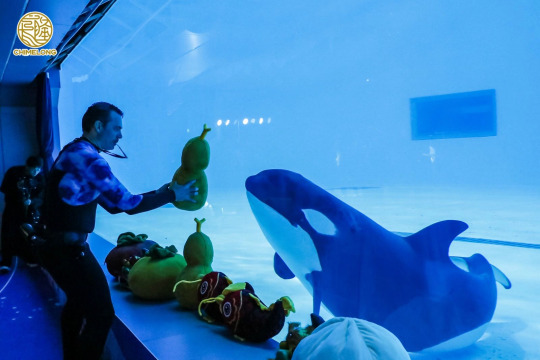

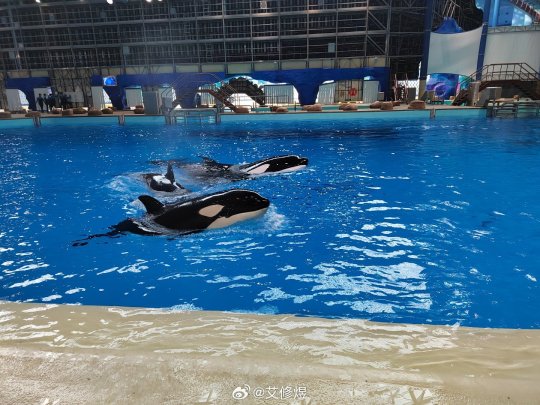
Earlier today Chimelong Spaceship for the first time uncovered the underwater viewing window looking into Pool C, one of the orca exhibit’s back pools, for the public debut of Katenka and her calf, together with Katniss and Loki. However, a curtain has been installed in front of that window, so it can be closed off to give the whales rest and privacy if needed.
http://xhslink.com/cLOsoy
http://xhslink.com/dgnSpy
https://weibo.com/2131427820/4984753261122203
22 notes
·
View notes
Text
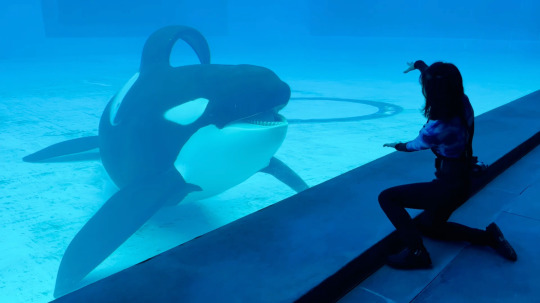

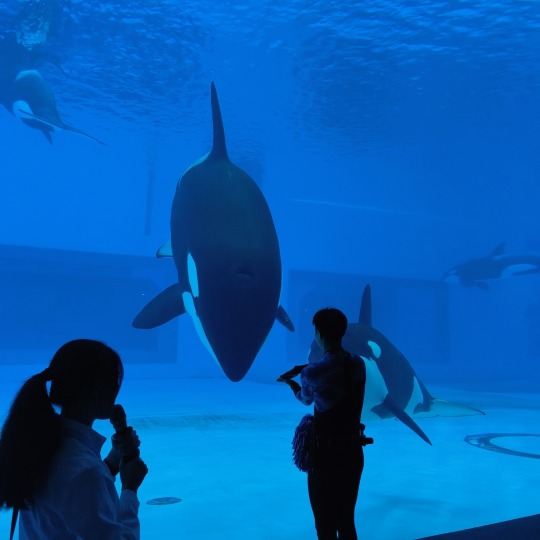

At Chimelong Spaceship, trainers/whales window interactions, combined with educational talks, take place at the main underwater viewing window.
19 notes
·
View notes
Text
The main underwater viewing window at Chimelong Spaceship’s killer whale exhibit
25 notes
·
View notes
Text
The wave machine is now testing at Chimelong Spaceship's upcoming killer whale exhibit.
27 notes
·
View notes
Text
Chimelong Spaceship’s orca exhibit is almost ready
12 notes
·
View notes